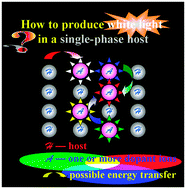How to produce white light in a single-phase host?
Abstract
White light-emitting diodes (WLEDs) as new solid-state light sources have a greatly promising application in the field of lighting and display. So far much effort has been devoted to exploring novel luminescent materials for WLEDs. Currently the major challenges in WLEDs are to achieve high luminous efficacy, high chromatic stability, brilliant color-rending properties, and price competitiveness against fluorescent lamps, which rely critically on the phosphor properties. In recent years, numerous efforts have been made to develop single-phase white-light-emitting phosphors for near-ultraviolet or ultraviolet excitation to solve the above challenges with certain achievements. This review article highlights the current methods to realize the white light emission in a single-phase host, including: (1) doping a single rare earth ion (Eu3+, Eu2+ or Dy3+) into appropriate single-phase hosts; (2) co-doping various luminescent ions with different emissions into a single matrix simultaneously, such as Tm3+/Tb3+/Eu3+, Tm3+/Dy3+, Yb3+/Er3+/Tm3+etc.; (3) codoping different ions in one host to control emission color via energy transfer processes; and (4) controlling the concentration of the defect and reaction conditions of defect-related luminescent materials.


 Please wait while we load your content...
Please wait while we load your content...